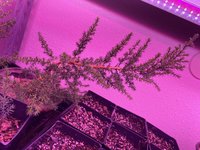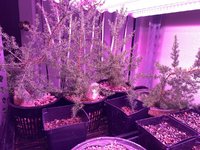Captain_Sensible
Seedling
Hi Everyone,
I'm new to this so any and all advice is appreciated (especially from anyone who has experience with this tree). A few months back I was given a Monterey Cypress seedling (2-3 years old). Most of my family lives in northern California and I was given it as a reminder of home. Which is great and I love this little tree. For the past few months it has been living and growing happily in a small (2x4 inch) bonsai pot. The problem is that I now live in eastern Pennsylvania and it is my understanding that in the winter temperatures drop below freezing for several days. From what I have read online these trees should never be exposed to freezing temperatures. So I am not sure what is best to do.
I have a detached non heated garage, I am considering insulating the pot in some way and placing it in the garage for the coldest 2 or so months. It will be protected from the wind but I think it will still get below freezing in the garage. If I go this route does anyone have any advice on how to insulate it? I am thinking mulch around the pot and base of the tree with burlap wrapped up to hold it in place but I have no idea how I should water it if its all wrapped up like this. One thing I am concerned about with this option is that it will receive very very very little light (if any) in the garage. Does that matter if it is dormant?
Should I bring it inside? I don't know how that may affect its dormancy period. I am not sure what type of dormancy these trees have. I could try to keep it in a room that may be colder than the rest of the house but I dont know yet how cold/warm that room may be.
I am in a new house in a new part of the country so there is a lot that I am not sure of what to expect. Any advice is greatly appreciated, I am happy to provide any additional info if needed.
Thanks all!
I'm new to this so any and all advice is appreciated (especially from anyone who has experience with this tree). A few months back I was given a Monterey Cypress seedling (2-3 years old). Most of my family lives in northern California and I was given it as a reminder of home. Which is great and I love this little tree. For the past few months it has been living and growing happily in a small (2x4 inch) bonsai pot. The problem is that I now live in eastern Pennsylvania and it is my understanding that in the winter temperatures drop below freezing for several days. From what I have read online these trees should never be exposed to freezing temperatures. So I am not sure what is best to do.
I have a detached non heated garage, I am considering insulating the pot in some way and placing it in the garage for the coldest 2 or so months. It will be protected from the wind but I think it will still get below freezing in the garage. If I go this route does anyone have any advice on how to insulate it? I am thinking mulch around the pot and base of the tree with burlap wrapped up to hold it in place but I have no idea how I should water it if its all wrapped up like this. One thing I am concerned about with this option is that it will receive very very very little light (if any) in the garage. Does that matter if it is dormant?
Should I bring it inside? I don't know how that may affect its dormancy period. I am not sure what type of dormancy these trees have. I could try to keep it in a room that may be colder than the rest of the house but I dont know yet how cold/warm that room may be.
I am in a new house in a new part of the country so there is a lot that I am not sure of what to expect. Any advice is greatly appreciated, I am happy to provide any additional info if needed.
Thanks all!





